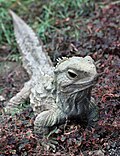Rhynchocephalia (redirect from Sphenodontia)
distribution by the Early Jurassic. Most rhynchocephalians belong to the group Sphenodontia ('wedge-teeth'). Their closest living relatives are lizards and snakes...
53 KB (5,251 words) - 05:51, 29 October 2024
This list of largest reptiles takes into consideration both body length and mass of large reptile species, including average ranges and maximum records...
78 KB (7,986 words) - 09:18, 1 November 2024
Testudines, Squamata and Crocodilia. The only missing extant order is Sphenodontia, containing the tuataras, which are endemic to New Zealand. Australia...
4 KB (215 words) - 13:40, 28 April 2022
List of reptiles (section Order Sphenodontia – tuatara)
Reptiles are tetrapod animals in the class Reptilia, comprising today's turtles, crocodilians, snakes, amphisbaenians, lizards, tuatara, and their extinct...
7 KB (555 words) - 06:57, 20 May 2024
Evolution of reptiles (section Sphenodontia)
reptilian orders. Squamates are a monophyletic group included, with the Sphenodontia (e.g. tuataras), in the Lepidosauria. The latter superorder, together...
30 KB (3,190 words) - 14:03, 10 September 2024
Eilenodontinae are an extinct clade of reptiles belonging to Sphenodontia. They are either considered a subgroup of Opisthodontia, or Sphenodontidae. They...
4 KB (383 words) - 00:04, 25 March 2024
of the Late Triassic Period. The Lepidosauromorpha, specifically the Sphenodontia, are first found in the fossil record of the earlier Carnian Age, though...
71 KB (7,725 words) - 00:25, 30 October 2024
what taxonomists call a "wastebasket taxon". Williston proposed the Sphenodontia to include only tuatara and their closest fossil relatives in 1925. However...
88 KB (9,483 words) - 13:45, 20 October 2024
La Boca Formation (section Sphenodontia)
The La Boca Formation is a geological formation in Tamaulipas state, northeast Mexico. It was originally thought to date back to the Early Jurassic, concretely...
38 KB (1,899 words) - 15:18, 4 October 2024
the Late Triassic of Europe. It is the most primitive known member of Sphenodontia. Diphydontosaurus was one of the smallest sphenodontians, measuring up...
7 KB (607 words) - 21:58, 22 March 2024








